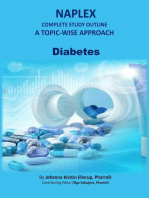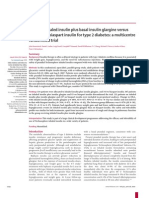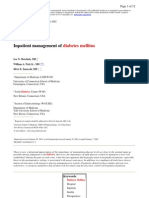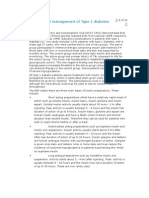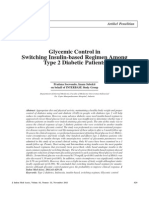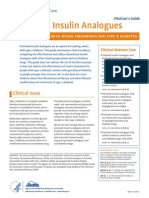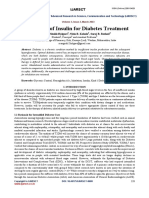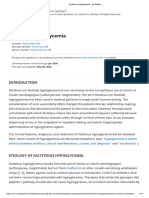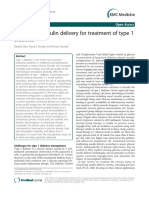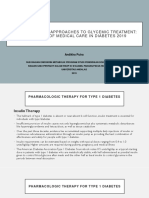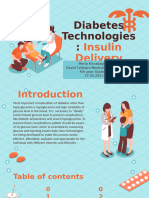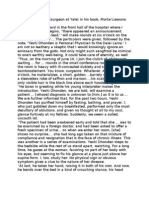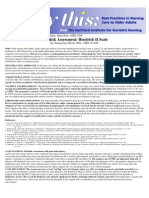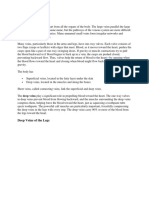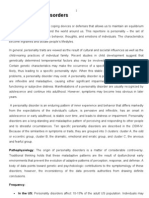0 ratings0% found this document useful (0 votes)
28 viewsNew Technologies and Therapies in The Management of Diabetes
New Technologies and Therapies in The Management of Diabetes
Uploaded by
ArhaMozaabout insulin
Copyright:
© All Rights Reserved
Available Formats
Download as PDF, TXT or read online from Scribd
New Technologies and Therapies in The Management of Diabetes
New Technologies and Therapies in The Management of Diabetes
Uploaded by
ArhaMoza0 ratings0% found this document useful (0 votes)
28 views8 pagesabout insulin
Original Title
Detemir
Copyright
© © All Rights Reserved
Available Formats
PDF, TXT or read online from Scribd
Share this document
Did you find this document useful?
Is this content inappropriate?
about insulin
Copyright:
© All Rights Reserved
Available Formats
Download as PDF, TXT or read online from Scribd
Download as pdf or txt
0 ratings0% found this document useful (0 votes)
28 views8 pagesNew Technologies and Therapies in The Management of Diabetes
New Technologies and Therapies in The Management of Diabetes
Uploaded by
ArhaMozaabout insulin
Copyright:
© All Rights Reserved
Available Formats
Download as PDF, TXT or read online from Scribd
Download as pdf or txt
You are on page 1of 8
Ascend Media
VOL. 13, NO. 2 I THE AMERICAN JOURNAL OF MANAGED CARE I S47
New Technologies and Therapies
in the Management of Diabetes
Curtis L. Triplitt, PharmD, CDE
Address correspondence to: Curtis L. Triplitt, PharmD, CDE, The University of Texas Health
Science Center at San Antonio, 7703 Floyd Curl Drive, San Antonio, TX 78229-3900. E-mail:
Curtis.Triplitt@uhs-sa.com.
Abstract
Although there are numerous effective
pharmacotherapeutic agents available to
treat type 2 diabetes, 5% to 10% of the
population with diabetes experience
secondary failure. To help combat this
issue, it is imperative that clinicians
understand the limitations of some
current therapies. Secondary failure can
be due to decreasing beta cell function,
poor adherence to treatment, weight gain,
reduction of exercise, changes in diet,
or illness.
Glycemic control and cardiovascular risk
reduction are of paramount concern;
however, the nonglycemic effects of
several new therapies to treat diabetes
may be advantageous and positively
affect the long-term cost of therapy.
The discoveries of amylin and glucagon-
like peptide-1 have furthered our under-
standing of the abnormalities involved
in diabetes, enabling the development
of additional therapeutic options. Incretin-
based therapy, including incretin mimetics
such as exenatide and the yet-to-be-
approved dipeptidyl peptidase-4 inhibi-
tors, and new basal and inhaled insulin
may change the way we currently treat
type 2 diabetes.
(Am J Manag Care. 2007;13:S47-S54)
I REPORTS I
A
lthough lifestyle measures are the cornerstone of diabetes
therapy, most patients will also require pharmacotherapy to
achieve target glucose concentrations. Different classes of
antidiabetic agents affect glucose homeostasis through dis-
tinct mechanisms (Figure 1).
1
Sulfonylureas and the nonsulfonylurea
secretagogues (meglitinides) increase endogenous insulin secretion;
alpha-glucosidase inhibitors delay intestinal carbohydrate absorption;
thiazolidinediones (TZDs) enhance insulin sensitivity primarily by
increasing peripheral glucose disposal, but also suppress hepatic glucose
production; and metformin, a biguanide, decreases hepatic glucose pro-
duction, but also increases peripheral glucose disposal to some extent.
1
Despite the number of conventional agents at our disposal, many
patients are unable to attain or maintain glycemic goals. The United
Kingdom Prospective Diabetes Study of glycemic control with insulin,
sulfonylurea, or metformin monotherapy found that approximately
50% of patients were unable to maintain glycemic goals (glycosylated
hemoglobin [A1C] <7%) by 3 years, and 75% did not maintain
glycemic control by 9 years.
2
A retrospective study of a health mainte-
nance organization database reported that 26% of patients treated with
insulin plus an oral agent and 13% to 30% of those receiving combi-
nation therapy with oral agents achieved optimal glycemic control
(A1C <7%).
3
Although conventional therapy should allow for much better
results, unmet needs exist with these therapies. Some of these needs
can be addressed with newer agents with different mechanisms of
action. Several novel antidiabetic agents have recently become avail-
able or are likely to be approved within the next several months. The
challenge is to integrate these agents appropriately into the treatment
paradigm in ways that will make the best use of their unique attributes.
Insulin
Two new options in insulin therapy have recently become avail-
able. Insulin detemir (Levemir), a long-lasting basal insulin, was
approved by the US Food and Drug Administration (FDA) in 2005,
and an inhaled form of insulin (Exubera) was approved in early 2006.
Reports
S48 I www.ajmc.com I APRIL 2007
Figure 2 shows the pharmacokinetics of these new
analogs in comparison with other forms of insulin.
4-6
Insulin Detemir. Insulin detemir has a unique
structure that results in a prolonged duration of
action for up to 24 hours. The insulin molecule is
acylated with a 14-carbon fatty acid, which allows it
to bind reversibly to albumin at the injection site
and in plasma. Albumin binding, together with
self-association of the molecules at the site of sub-
cutaneous (SC) injection, is responsible for the pro-
tracted action of insulin detemir.
4
A very small
percent of albumin molecules are actually bound,
however, and there are no known drugdrug inter-
actions between insulin detemir and other drugs
that bind albumin.
4,7
The pharmacokinetics of insulin detemir are
dose-dependent, with lower doses resulting in a
shorter duration of action (Table).
8
In clinical stud-
ies, the average daily insulin detemir dose was 0.38
U/kg for adults with type 1 diabetes and 0.77 U/kg
for adults with type 2 diabetes.
7
At these doses,
activity is maintained for approximately 20 to 24
hours, peaking at 8 to 9 hours after administration.
8
Insulin detemir is typically given once- or twice-
daily by SC injection.
7
Studies have reported that insulin detemir has
less within-subject variability and a lower risk of
hypoglycemia, particularly nocturnal hypoglycemia,
than human neutral protamine Hagedorn insulin.
9
Treatment with insulin detemir also resulted in
lower within-subject variability than insulin
glargine.
10,11
Inhaled Insulin. The first inhaled form of
insulin to be approved by the FDA is Exubera, an
insulin inhalation powder. Exubera consists of blis-
ters containing human insulin inhalation powder,
which is administered using the Exubera inhaler.
12
The 1-mg and 3-mg doses are approximately equiv-
alent to 3 IU and 8 IU of SC regular human insulin,
respectively.
Randomized studies have shown that the efficacy
of inhaled insulin is comparable with subcutaneously
I Figure 1. Pathophysiological Basis of Conventional Diabetes Therapies
Adapted with permission from Reference 1.
TZDs indicates thiazolidinediones.
New Technologies and Therapies in the Management of Diabetes
VOL. 13, NO. 2 I THE AMERICAN JOURNAL OF MANAGED CARE I S49
injected prandial human insulin in patients with type
1 and type 2 diabetes.
13,14
In patients with type 2 dia-
betes, inhaled insulin therapy was associated with
improved glycemic control compared with rosiglita-
zone in patients whose diabetes was not controlled by
diet and exercise.
15
Another study evaluated the
switch to or addition of inhaled insulin in subjects
not at goal despite oral combination therapy.
16
Inhaled insulin, alone or in combination with oral
therapy, resulted in significant reductions in A1C
compared with continuing combination oral therapy
alone (mean adjusted reductions of 1.4% and 1.7%,
respectively). A1C levels <7% were achieved by
32% of patients in the inhaled insulin plus oral ther-
apy group, 17% of patients in the inhaled insulin
monotherapy group, and 1% of patients who
remained on oral combination therapy.
16
Patient satisfaction and quality of life outcomes,
including burden, convenience, pain, and psycho-
logical well-being, were significantly higher with
inhaled insulin treatment compared with SC insulin
in patients with type 1 diabetes.
14
Patient preference
for this form of insulin therapy was further demon-
strated in a study in which patients with type 1 or
type 2 diabetes were allowed to switch therapies at
the end of a 12-week randomized phase comparing
inhaled insulin with subcutaneously injected human
insulin. Eighty-five percent of patients who were
randomized to inhaled insulin continued treatment,
whereas only 13% switched to SC insulin. In the
group randomized to SC insulin, only 21% contin-
ued treatment; whereas 76% switched to inhaled
insulin.
17
Treatment satisfaction scores were signifi-
cantly higher among patients receiving inhaled
insulin in both phases of this study.
Moreover, in a study of theoretical treatment
choices among patients with type 2 diabetes failing
to achieve target glycemic control despite lifestyle
and/or oral agent treatment, the availability of
inhaled insulin as a treatment option significantly
increased the proportion of patients who would
theoretically choose insulin overall. Patients were
3 times more likely to choose insulin therapy when
inhaled insulin was available, and inhaled insulin
was the most frequently chosen treatment option.
18
As with subcutaneously injected insulin, the
most frequent adverse event with inhaled insulin is
hypoglycemia. Frequency of hypoglycemia was sim-
ilar in the clinical trials that compared inhaled and
SC insulin.
The use of inhaled insulin is contraindicated in
patients with unstable or poorly controlled lung dis-
ease and in those who smoke, including those who
stopped smoking less than 6 months before consider-
ation for treatment with Exubera. The use of Exubera
in patients with underlying lung disease, such as
I Table. Dose-dependent Pharmacokinetics of Insulin Detemir*
Dose (U/kg)
Parameter 0.1 0.2 0.4 0.8 1.6
Onset of action (h) 2.0 2.0 1.6 1.1 0.8
Time to peak (h) 3.2 6.2 8.6 9.3 8.7
Duration of action (h) 5.7 12.1 19.9 22.7 23.2
*Data shown are mean values.
Source: Reference 8.
I Figure 2. Pharmacokinetics of Different Forms of Insulin
NPH indicates neutral protamine Hagedorn.
Sources: References 4-6.
Reports
S50 I www.ajmc.com I APRIL 2007
asthma or chronic obstructive pulmonary disease, is
not recommended, because the safety and efficacy of
Exubera in this population have not been estab-
lished. All patients should have spirometry (forced
expiratory volume in 1 second [FEV
1
]) assessed
before initiating therapy. Assessment of lung diffu-
sion capacity of carbon monoxide (DLCO) should
be considered. Pulmonary function assessment
should be repeated 6 months after initiation and
annually thereafter.
12
During the 2-year clinical trials,
declines from baseline FEV
1
of
>
20% were observed
in 1.5% of patients treated with inhaled insulin
compared with 1.3% in the comparator group, and
declines from baseline DLCO
>
20% occurred in
5.1% of patients treated with inhaled insulin com-
pared with 3.6% in the comparator group.
12
Amylinomimetics
Amylin is a neuroendocrine hormone that is co-
secreted with insulin from pancreatic beta cells in
response to meals. Amylin inhibits postprandial
glucagon secretion, slows the rate of gastric empty-
ing, enhances satiety, and reduces food intake.
Together, these amylin-mediated activities result in
the suppression of postprandial glucose excur-
sions.
19,20
Because of the co-localization of amylin
and insulin within beta cells, patients with type 1
diabetes have an absolute deficiency of both, where-
as patients with type 2 diabetes have a relative defi-
ciency of both hormones, including a markedly
impaired amylin and insulin response to meals.
21
Native amylin is insoluble and aggregates in
solution, and therefore is not suitable for pharmaco-
logic administration. The development of a soluble
peptide analog of amylin, pramlintide, circumvent-
ed this difficulty and allowed clinical studies of
amylin-based therapy.
22
In 2005, pramlintide was
approved by the FDA for use in patients with dia-
betes treated with mealtime insulin who have not
achieved glycemic goals.
23
Clinical studies have shown that pramlintide
treatment significantly reduces postprandial
glucagon secretion in insulin-treated patients with
type 1 or type 2 diabetes, leading to improved post-
prandial glycemic control.
19
Sustained reductions in
A1C levels are observed in response to pramlintide
treatment, ranging from about 0.1% to 0.67% in
patients with type 1 diabetes and from 0.3% to
0.62% in patients with type 2 diabetes.
22
The most
frequent side effect of pramlintide is nausea, which
is generally mild to moderate and diminishes over
time. Higher doses are associated with a greater
incidence of nausea.
22
For this reason, pramlintide
dosage is titrated on the basis of response and toler-
ability. Because pramlintide improves glycemic con-
trol and often results in decreased caloric intake, it
has been associated with an increased incidence of
insulin-induced hypoglycemia, particularly in
patients with type 1 diabetes. Initial prandial
insulin dose reductions, along with starting pram-
lintide at a low dose, are therefore required when
initiating therapy.
23
Incretin-based Therapy
The Incretin Effect. In healthy nondiabetic
subjects, oral administration of glucose produces a
substantially enhanced insulin response compared
with intravenous administration of glucose that
results in a similar glucose excursion. This discrep-
ancy has been called the incretin effect, and this
effect is diminished in people with type 2 diabetes.
24
Subsequent studies identified 2 primary gut-derived
hormones that are responsible for most of the
incretin effect: glucose-dependent insulinotropic
peptide (GIP) and glucagon-like peptide-1 (GLP-
1). GLP-1 is a better therapeutic target and has
accordingly been studied to a greater extent.
25
GLP-1 inhibits postprandial glucagon release
and stimulates glucose-dependent insulin secre-
tion.
26,27
This hormone also slows gastric emptying
and enhances satiety.
26,28
At least in animals, at the
cellular level GLP-1 appears to stimulate beta cell
growth and survival and reduce apoptosis, leading
to increases in beta cell mass (Figure 3).
26-29
Unfortunately, GLP-1 has an in vivo half-life of
less than 2 minutes, which prevents it from being an
attractive therapeutic candidate. The major meta-
bolic pathway for GLP-1 is degradation by dipep-
tidyl peptidase-4 (DPP-4); this enzyme cleaves the
NH-2 terminus of GLP-1 and related peptides,
including GIP.
30
Two strategies have been pursued
to allow therapeutic agents to circumvent this rapid
degradation: incretin mimetics, which involve
GLP-1 agonists or analogs that are resistant to DPP-
4mediated degradation, and DPP-4 inhibitors,
that prolong the half-life of endogenous GLP-1.
Incretin Mimetics. The only currently available
New Technologies and Therapies in the Management of Diabetes
VOL. 13, NO. 2 I THE AMERICAN JOURNAL OF MANAGED CARE I S51
incretin mimetic is exenatide (Byetta), a GLP-1
agonist that was approved by the FDA in 2005 as
adjunctive therapy for patients with type 2 diabetes
who are taking metformin and/or a sulfonylurea, or
a TZD with or without metformin. Exenatide is a
synthetic analog of exendin-4, a peptide found in
Gila monster saliva, that binds to and activates the
human GLP-1 receptor.
25,31
In 30-week clinical tri-
als, exenatide at a dose of 10 g SC twice daily
reduced A1C levels by a placebo-subtracted 0.9%
to 1.0% in patients with type 2 diabetes who were
receiving treatment with metformin and/or a sul-
fonylurea. These trials also reported a dose-depend-
ent weight loss of 1.6 to 2.8 kg from baseline with
exenatide at the 10-g twice-daily dose.
32-34
Patients who received exenatide in the original
30-week placebo-controlled trials were eligible for
entry into a 1-year open-label extension trial. Long-
term data from this study indicate that A1C reduc-
tions in response to exenatide were sustained over
82 weeks (30-week controlled trial + 1-year open-
label extension). Greater A1C reductions are seen
with higher baseline A1C levels (Figure 4), with
reductions of 1.6% to 2% in patients with baseline
A1C
>
9%.
35
The sustained reductions in A1C may be related
to the effects of exenatide on pancreatic beta cells.
Consistent with the known activities of GLP-1,
exenatide promotes beta cell proliferation and dif-
ferentiation in animal models and also enhances
beta cell function in patients with type 2 diabetes.
36
Weight loss did not plateau but continued
throughout 82 weeks of exenatide treatment, with a
mean reduction from baseline of 4.4 kg. Weight loss
occurred in the absence of formal nutrition or exer-
cise instructions and was not dependent on nausea.
Improvements in other cardiovascular risk factors,
including increases in high-density lipoprotein and
decreases in diastolic blood pressure, were also
observed.
35
Exenatide enhances endogenous insulin secre-
tion in a glucose-dependent manner (ie, insulin
secretion diminishes as glucose levels decrease into
the normal range). This should reduce the risk for
hypoglycemia with exenatide. As might be expect-
ed, exenatide in combination with metformin was
associated with no greater incidence of hypo-
glycemia than exenatide plus placebo.
33
Addi-
tionally, under hypoglycemic conditions in healthy
controls, exenatide does not impair the counterreg-
ulatory response to hypoglycemia.
37
In contrast to
the situation with exenatide, sulfonylurea-induced
insulin secretion is not glucose-dependent, and
increased rates of hypoglycemia have been observed
when exenatide was added to the regimen of
patients treated with sulfonylureas or sulfonylureas
plus metformin.
32,34
Recently, exenatide received FDA approval for
use in combination with a TZD. Exenatide
decreased A1C by 0.8 0.9% from a baseline of
7.9 0.9% when added to patients with type 2 dia-
betes not at goal despite treatment with a TZD
alone or in combination with metformin. Improved
glycemic control was not associated with a greater
risk of hypoglycemia than placebo and was associat-
ed with a 1.5 3.1-kg weight change.
38
As with
metformin, the mechanism of action of TZDs does
not lead to hypoglycemia, which may make it possi-
ble to employ triple combination therapy without
increasing the risk of hypoglycemia. Additionally,
combination therapy may limit the weight gain
often seen with TZD therapy.
Another incretin mimetic, liraglutide, is cur-
rently undergoing FDA regulatory trials. This com-
pound is an acylated GLP-1 analog that is bound to
albumin and has a half-life of about 12 hours.
25,39,40
A once-daily injection of liraglutide was evaluated
in a double-blind, placebo-controlled, randomized
I Figure 3. Effects of Glucagon-like Peptide-1 (GLP-1) on
Glucose Homeostasis
Sources: References 26-29.
Reports
S52 I www.ajmc.com I APRIL 2007
trial in patients with type 2 diabetes. At the highest
liraglutide dose (0.75 mg), A1C reductions of
0.75% were recorded at 12 weeks; this decrease was
almost identical to that observed in the open-label
comparator arm in which patients received
glimepiride (0.74% reduction).
41
Liraglutide was
also effective in improving glycemic control in met-
formin-treated patients (A1C reduction of 0.8%
over 5 weeks).
42
As with exenatide, liraglutide has
been reported to enhance beta cell function
43
and is
associated with decreases in body weight.
41,42
DPP-4 Inhibitors. The most recent agent to be
approved by the FDA for the treatment of type 2 dia-
betes is sitagliptin (Januvia), an oral, once-daily DPP-
4 inhibitor that can be given alone or in combination
with metformin or a TZD.
44
Sitagliptin-mediated
inhibition of DPP-4 results in an approximately 2- to
3-fold increase in endogenous GIP and GLP-1 lev-
els.
44
A1C reductions of 0.65% were reported when
sitagliptin was administered to metformin-treated
patients,
45
whereas monotherapy was associated with
placebo-subtracted A1C reductions of 0.79% to
0.94%.
46
Sitagliptin-mediated effects were depend-
ent on baseline A1C; patients with baseline levels
>
9% showed placebo-subtracted A1C reductions of
1.5% with sitagliptin monotherapy. A1C reduc-
tions were accompanied by improvements in mea-
sures of beta cell function.
46
Sitagliptin is primarily eliminated via renal
excretion, and 2- to 4-fold increases in plasma lev-
els have been observed in patients with moderate-
to-severe renal insufficiency. For this reason, renal
function testing should be performed before initia-
tion of sitagliptin therapy and periodically during
treatment. Dosage adjustments are recommended in
patients with moderate renal insufficiency and in
patients with severe renal insufficiency or with end-
stage renal disease requiring hemodialysis or peri-
toneal dialysis.
44
Vildagliptin (LAF237) is another oral DPP-4
inhibitor currently in phase 3 trials. Vildagliptin at
a dose of 50 mg once daily was added to ongoing
metformin in a double-blind, placebo-controlled,
randomized trial of patients with type 2 diabetes. In
the vildagliptin arm, A1C levels decreased by 0.6%
over 12 weeks; sustained reductions were observed
in the 40-week extension study. However, during
that time A1C levels in the placebo group contin-
ued to rise, resulting in a between-group difference
of 1.1% after 1 year. Weight reductions in the place-
bo and vildagliptin arms were comparable at 12
weeks and identical (0.2 kg) at 1 year.
47
A separate
study reported that vildagliptin improved beta cell
function in patients with type 2 diabetes by increas-
ing the insulin secretory rate.
48
Management of Type 2 Diabetes in the Future
The choice of diabetic therapies will likely
continue to expand in the coming years.
Additional insulins to be delivered by pulmonary
inhalation and other noninjection delivery sys-
tems are under development and/or in trials.
Other oral antihyperglycemic agents are also
being investigated.
REFERENCES
1. Inzucchi SE. Oral antihyperglycemic therapy for type
2 diabetes: scientific review. JAMA. 2002;287:360-372.
2. Turner RC, Cull CA, Frighi V, Holman RR; UK Prospective
Diabetes Study (UKPDS) Group. Glycemic control with
diet, sulfonylurea, metformin, or insulin in patients
with type 2 diabetes mellitus: progressive requirement
for multiple therapies (UKPDS 49). JAMA. 1999;281:
2005-2012.
3. Willey CJ, Andrade SE, Cohen J, Fuller JC, Gurwitz JH.
Polypharmacy with oral antidiabetic agents: an indica-
I Figure 4. Baseline-dependent Glycosylated
Hemoglobin (A1C) Reductions in 314 Patients
Treated With Exenatide in Addition to
Sulfonylurea and/or Metformin
For patients with baseline A1C
>
9%, mean baseline
A1C = 9.7%.
For patients with baseline A1C < 9%, mean baseline
A1C = 7.8%.
Source: Reference 35.
New Technologies and Therapies in the Management of Diabetes
VOL. 13, NO. 2 I THE AMERICAN JOURNAL OF MANAGED CARE I S53
tor of poor glycemic control. Am J Manag Care. 2006;
12:435-440.
4. Chapman TM, Perry CM. Insulin detemir. A review of
its use in the management of type 1 and 2 diabetes
mellitus. Drugs. 2004;64:2577-2595.
5. DeWitt DE, Hirsch IB. Outpatient insulin therapy in
type 1 and type 2 diabetes mellitus. Scientific review.
JAMA. 2003;289:2254-2264.
6. Rave K, Bott S, Heinemann L, et al. Time-action profile
of inhaled insulin in comparison with subcutaneously
injected insulin lispro and regular human insulin.
Diabetes Care. 2005;28:1077-1082.
7. Levemir (insulin detemir [rDNA origin] injection)
[package insert]. Princeton, NJ: Novo Nordisk Inc; 2005.
8. Plank J, Bodenlenz M, Sinner F, et al. A double-blind,
randomized, dose-response study investigating the
pharmacodynamic and pharmacokinetic properties of
the long-acting insulin analog detemir. Diabetes Care.
2005;28:1107-1112.
9. Valensi P, Cosson E. Is insulin detemir able to favor a
lower variability in the action of injected insulin in dia-
betic subjects. Diabetes Metab. 2005;31:4S34-4S39.
10. Heise T, Nosek L, Ronn BB, et al. Lower within-subject
variability of insulin detemir in comparison to NPH
insulin and insulin glargine in people with type 1 dia-
betes. Diabetes. 2004;53:1614-1620.
11. Pieber TR, Treichel HC, Robertson LI, Mordhorst L, Gall
MA. Insulin detemir plus insulin aspart is associated
with less risk of major as well as nocturnal hypo-
glycemia than insulin glargine plus insulin aspart at
comparable levels of glycaemic control in type 1
diabetes. Abstract presented at: 41st Annual Meeting
of the European Association for the Study of Diabetes;
September 10-15, 2005; Athens, Greece. Abstract 242.
12. Exubera (insulin human [rDNA origin]) inhalation
powder [package insert]. New York, NY: Pfizer Labs;
2006.
13. Skyler JS, Weinstock RS, Raskin P, et al; Inhaled Insulin
Phase III Type 1 Diabetes Study Group. Use of inhaled
insulin in a basal/bolus insulin regimen in type 1 dia-
betic subjects. A 6-month, randomized, comparative
trial. Diabetes Care. 2005;28:1630-1635.
14. Quattrin T, Blanger A, Bohannon NJV, Schwartz SL;
Exubera Phase III Study Group. Efficacy and safety of
inhaled insulin (Exubera) compared with subcutaneous
insulin therapy in patients with type 1 diabetes. Results
of a 6-month, randomized, comparative trial. Diabetes
Care. 2004;27:2622-2627.
15. DeFronzo RA, Bergenstal RM, Cefalu WT, et al; Exubera
Phase III Study Group. Efficacy of inhaled insulin in
patients with type 2 diabetes not controlled with diet
and exercise. A 12-week, randomized, comparative
trial. Diabetes Care. 2005;28:1922-1928.
16. Rosenstock J, Zinman B, Murphy LJ, et al. Inhaled
insulin improves glycemic control when substituted for
or added to oral combination therapy in type 2 dia-
betes. A randomized, controlled trial. Ann Intern Med.
2005;143:549-558.
17. Rosenstock J, Cappelleri JC, Bolinder B, Gerber RA.
Patient satisfaction and glycemic control after 1 year
with inhaled insulin (Exubera) in patients with type 1 or
type 2 diabetes. Diabetes Care. 2004;27:1318-1323.
18. Freemantle N, Blonde L, Duhot D, et al. Availability of
inhaled insulin promotes greater perceived acceptance
of insulin therapy in patients with type 2 diabetes.
Diabetes Care. 2005;28:427-428.
19. Schmitz O, Brock B, Rungby J. Amylin agonists: a
novel approach in the treatment of diabetes. Diabetes.
2004;53(suppl 3):S233-S238.
20. Hollander PA, Levy P, Fineman MS, et al. Pramlintide
as an adjunct to insulin therapy improves long-term
glycemic and weight control in patients with type 2
diabetes. Diabetes Care. 2003;26:784-790.
21. Buse JB, Weyer C, Maggs DG. Amylin replacement
with pramlintide in type 1 and type 2 diabetes: a physi-
ological approach to overcome barriers with insulin
therapy. Clin Diabetes. 2002;20:137-144.
22. Ryan GJ, Jobe LJ, Martin R. Pramlintide in the treat-
ment of type 1 and type 2 diabetes mellitus. Clin Ther.
2005;27:1500-1512.
23. Symlin (pramlintide acetate) injection [package
insert]. San Diego, Calif: Amylin Pharmaceuticals, Inc;
2005.
24. Nauck M, Stockmann F, Ebert R, Creutzfeldt W.
Reduced incretin effect in type 2 (non-insulin-depend-
ent) diabetes. Diabetologia. 1986;29:46-52.
25. Blonde L, Rosenstock J, Triplitt C. What are incretins,
and how will they influence the management of type 2
diabetes? J Manag Care Pharm. 2006;12(7 suppl A):2-12.
26. Nauck MA, Wollschlager D, Werner J, et al. Effects of
subcutaneous glucagon-like peptide 1 (GLP-1 [7-36
amide]) in patients with NIDDM. Diabetologia. 1996;39:
1546-1553.
27. Larsson H, Holst JJ, Ahren B. Glucagon-like peptide
reduces hepatic glucose production indirectly through
insulin and glucagon in humans. Acta Physiol Scand.
1997;160:413-422.
28. Flint A, Raben A, Astrup A, Holst JJ. Glucagon-like
peptide 1 promotes satiety and suppresses energy
intake in humans. J Clin Invest. 1998;101:515-520.
29. Deacon CF. Therapeutic strategies based on gluca-
gon-like peptide 1. Diabetes. 2004;53:2181-2189.
30. Drucker DJ. Glucagon-like peptides. Diabetes.
1998;47:159-169.
31. Byetta (exenatide) injection [package insert]. San
Diego, Calif: Amylin Pharmaceuticals, Inc; 2006.
32. Buse JB, Henry RR, Han J, Kim DD, Fineman MS,
Baron AD; Exenatide-113 Clinical Study Group. Effects of
exenatide (exendin-4) on glycemic control over 30
weeks in sulfonylurea-treated patients with type 2 dia-
betes. Diabetes Care. 2004;27:2628-2635.
33. DeFronzo RA, Ratner RE, Han J, Kim DD, Fineman MS,
Baron AD. Effects of exenatide (exendin-4) on glycemic
control and weight over 30 weeks in metformin-treated
patients with type 2 diabetes. Diabetes Care. 2005;28:
1092-1100.
34. Kendall DM, Riddle MC, Rosenstock J, et al. Effects of
exenatide (exendin-4) on glycemic control over 30
weeks in patients with type 2 diabetes treated with
metformin and a sulfonylurea. Diabetes Care.
2005;28:1083-1091.
35. Blonde L, Klein EJ, Han J, et al. Interim analysis of
the effects of exenatide treatment on A1C, weight and
cardiovascular risk factors over 82 weeks in 314 over-
weight patients with type 2 diabetes. Diabetes Obes
Metab. 2006;8:436-447.
36. Fineman MS, Bicsak TA, Shen LZ, et al. Effect on
glycemic control of exenatide (synthetic exendin-4)
additive to existing metformin and/or sulfonylurea
treatment in patients with type 2 diabetes. Diabetes
Care. 2003;26:2370-2377.
37. Degn KB, Brock B, Juhl CB, et al. Effect of intra-
venous infusion of exenatide (synthetic exendin-4)
on glucose-dependent insulin secretion and counter-
regulation during hypoglycemia. Diabetes. 2004;53:
2397-2403.
38. Zinman B, Hoogwerf B, Garcia SD, et al. Safety and
efficacy of exenatide in patients with type 2 diabetes
mellitus using thiazolidinediones with or without met-
formin. Abstract presented at: the American Diabetes
Reports
S54 I www.ajmc.com I APRIL 2007
Association 66th Scientific Sessions; June 9-13, 2006;
Washington, DC. Abstract 117-OR.
39. Agerso H, Jensen LB, Elbrond B, Rolan P, Zdravkovic M.
The pharmacokinetics, pharmacodynamics, safety and
tolerability of NN2211, a new long-acting GLP-1 deriva-
tive, in healthy men. Diabetologia. 2002;45:195-202.
40. Juhl C, Hollingdal M, Sturis J, et al. Bedtime adminis-
tration of NN2211, a long acting GLP-1 derivative, sub-
stantially reduces fasting and postprandial glycemia in
type 2 diabetes. Diabetes. 2002;52:424-429.
41. Madsbad S, Schmitz O, Jakobsen G, Ranstam J,
Matthews DR; NN2211-1310 International Study Group.
Improved glycemic control with no weight increase in
patients with type 2 diabetes after once-daily treatment
with the long-acting glucagon-like peptide 1 analog
liraglutide (NN2211). A 12-week, double-blind, random-
ized, controlled trial. Diabetes Care. 2004;27:1335-1342.
42. Nauck MA, Hompesch M, Filipczak R, Le TDT,
Zdravkovic M, Gumprecht J; NN2211-1499 Study Group.
Five weeks of treatment with the GLP-1 analogue
liraglutide improves glycaemic control and lowers
body weight in subjects with type 2 diabetes. Exp Clin
Endocrinol Diabetes. 2006;114:417-423.
43. Degn KB, Juhl CB, Sturis J, et al. One weeks treat-
ment with the long-acting glucagon-like peptide 1
derivative liraglutide (NN2211) markedly improves 24-h
glycemia and - and -cell function and reduces
endogenous glucose release in patients with type 2
diabetes. Diabetes. 2004;53:1187-1194.
44. Januvia (sitagliptin phosphate) tablets [package
insert]. Whitehouse Station, NJ: Merck & Co, Inc;
2006.
45. Charbonnel B, Karasik A, Liu J, Wu M, Meininger G;
Sitagliptin Study 020 Group. Efficacy and safety of the
dipeptidyl peptidase-4 inhibitor sitagliptin added to
ongoing metformin therapy in patients with type 2
diabetes inadequately controlled with metformin
alone. Diabetes Care. 2006;29:2638-2643.
46. Aschner P, Kipnes MS, Lunceford JK, Sanchez M,
Mickel C, Williams-Herman DE; Sitagliptin Study 021
Group. Effect of the dipeptidyl peptidase-4 inhibitor
sitagliptin as monotherapy on glycemic control in
patients with type 2 diabetes. Diabetes Care. 2006;
29:2632-2637.
47. Ahren B, Gomis R, Standl E, Mills D, Schweizer A.
Twelve- and 52-week efficacy of the dipeptidyl pepti-
dase IV inhibitor LAF237 in metformin-treated patients
with type 2 diabetes. Diabetes Care. 2004;27:2874-2880.
48. Mari A, Sallas WM, He YL, et al. Vildagliptin, a dipep-
tidyl peptidase-IV inhibitor, improves model-assessed
-cell function in patients with type 2 diabetes. J Clin
Endocrinol Metab. 2005;90:4888-4894.
You might also like
- Thinking Like A PancreasDocument3 pagesThinking Like A Pancreasdevabakhti100% (2)
- Proaf For Nbe Vivek Jain PDFDocument7 pagesProaf For Nbe Vivek Jain PDFAjinkya JadhaoNo ratings yet
- Insulin Therapy For Type 2 Diabetes Mellitus.Document11 pagesInsulin Therapy For Type 2 Diabetes Mellitus.Clarissa CozziNo ratings yet
- Practical Insulin: A Handbook for Prescribing ProvidersFrom EverandPractical Insulin: A Handbook for Prescribing ProvidersRating: 5 out of 5 stars5/5 (2)
- Naplex Complete Study Outline A Topic-Wise Approach DiabetesFrom EverandNaplex Complete Study Outline A Topic-Wise Approach DiabetesRating: 4 out of 5 stars4/5 (3)
- Magical Drafts and PotionsDocument62 pagesMagical Drafts and PotionsBrianna Gittos100% (3)
- Antidiabetes Oral Kombinasi InsulinDocument10 pagesAntidiabetes Oral Kombinasi InsulinseptariefNo ratings yet
- CetoacidosisDocument5 pagesCetoacidosismagaguruNo ratings yet
- Insulin TherapyDocument14 pagesInsulin TherapyElimar Alejandra David GilNo ratings yet
- Ratner 2011 Preprandial Vs Postprandial GlulisineDocument7 pagesRatner 2011 Preprandial Vs Postprandial GlulisineKusumaNo ratings yet
- Combination Treatment With Insulin and Oral Agents in Type 2 Diabetes MellitusDocument6 pagesCombination Treatment With Insulin and Oral Agents in Type 2 Diabetes MellitusEstiPramestiningtyasNo ratings yet
- NONE BDocument11 pagesNONE BPincelito21No ratings yet
- Effective Use of Insulin Therapy in Type 2 DiabetesDocument7 pagesEffective Use of Insulin Therapy in Type 2 DiabetesmariohuangNo ratings yet
- Diabetes Care 2015Document8 pagesDiabetes Care 2015Bego Zubieta100% (1)
- Why Is Premixed Insulin The Preferred Insulin? Novel Answers To A Decade-Old QuestionDocument3 pagesWhy Is Premixed Insulin The Preferred Insulin? Novel Answers To A Decade-Old QuestionDanielShenfieldNo ratings yet
- Pharmacology ResearchDocument20 pagesPharmacology ResearchaagalhazmiNo ratings yet
- Inpatient Management of Diabetes MellitusDocument12 pagesInpatient Management of Diabetes MellitusSusi CipitNo ratings yet
- Jurnal DMDocument5 pagesJurnal DMratihparmadiniNo ratings yet
- Title of The Research: Diabetes Mellitus By: Abdelrahman Gamal Course Title: Pharmacology Academic Year: Fourth 2019-2020Document11 pagesTitle of The Research: Diabetes Mellitus By: Abdelrahman Gamal Course Title: Pharmacology Academic Year: Fourth 2019-2020LAZKILLERNo ratings yet
- International Journal of Pharmaceutics: Lia Bally, Hood Thabit, Roman HovorkaDocument10 pagesInternational Journal of Pharmaceutics: Lia Bally, Hood Thabit, Roman HovorkaBrasoveanu GheorghitaNo ratings yet
- Pharmacological Management of Type 1 DiabetesDocument6 pagesPharmacological Management of Type 1 DiabetesMI RFNo ratings yet
- Managemen Terpadu Pada Tatalaksana DM Tipe 2 Yang KomplikasiDocument6 pagesManagemen Terpadu Pada Tatalaksana DM Tipe 2 Yang KomplikasiSukamto Wei ShenNo ratings yet
- Insulin Analogs Versus Human Insulin in The Treatment of Patients With Diabetic KetoacidosisDocument6 pagesInsulin Analogs Versus Human Insulin in The Treatment of Patients With Diabetic KetoacidosisrosieveliaNo ratings yet
- DM GuidelinesDocument7 pagesDM GuidelinesslojnotakNo ratings yet
- Khazai 2016 Inpatient Diabetes Management in The Twenty First CenturyDocument20 pagesKhazai 2016 Inpatient Diabetes Management in The Twenty First CenturyMelissa cervantes montoyaNo ratings yet
- Insulin Clinician5 PharmacyDocument4 pagesInsulin Clinician5 PharmacydafaloveNo ratings yet
- Paper 8688Document14 pagesPaper 8688IJARSCT JournalNo ratings yet
- Https:/zero Sci-Hub Se/5089//boulet2016Document10 pagesHttps:/zero Sci-Hub Se/5089//boulet2016Caroline QueirogaNo ratings yet
- Hayatt Univesity College. Faculty of Medicine. Family Medicine. Mohamed Gassim Mohamed. Insulin ManagementDocument14 pagesHayatt Univesity College. Faculty of Medicine. Family Medicine. Mohamed Gassim Mohamed. Insulin ManagementMohammed GassimNo ratings yet
- VHRM - 6098 - Inhaled Insulin - An Overview of A Novel Form of Inhaled Ins - 011310Document12 pagesVHRM - 6098 - Inhaled Insulin - An Overview of A Novel Form of Inhaled Ins - 011310Rubana Reaz TanaNo ratings yet
- Premixed Insulin Analogue Compared With Basal-Plus Regimen For Inpatient Glycemic ControlDocument9 pagesPremixed Insulin Analogue Compared With Basal-Plus Regimen For Inpatient Glycemic ControlAbraham RamonNo ratings yet
- Research Article: Continuous Drug Infusion For Diabetes Therapy: A Closed-Loop Control System DesignDocument10 pagesResearch Article: Continuous Drug Infusion For Diabetes Therapy: A Closed-Loop Control System DesignBrasoveanu GheorghitaNo ratings yet
- Treatment of Patients With Type 1 Diabetes Insulin Pumps or Multiple Injections 2016 Biocybernetics and Biomedical EngineeringDocument8 pagesTreatment of Patients With Type 1 Diabetes Insulin Pumps or Multiple Injections 2016 Biocybernetics and Biomedical EngineeringJose J.No ratings yet
- Insulin Resistance IcuDocument18 pagesInsulin Resistance IcuLucero GutierrezNo ratings yet
- Insulin TherapyDocument10 pagesInsulin Therapymandloianand51No ratings yet
- G5 Dispensing LectureDocument20 pagesG5 Dispensing LectureCristine LalunaNo ratings yet
- dc25s009Document26 pagesdc25s009Camila S.No ratings yet
- JURNAL - Aspart InsulinDocument8 pagesJURNAL - Aspart InsulinTazkiyatan IsriaNo ratings yet
- Case Insulin 2Document7 pagesCase Insulin 2Yudi FadilahNo ratings yet
- Indikasi Insulin InfusionDocument7 pagesIndikasi Insulin InfusionnikeNo ratings yet
- JETIR1905867 - Reduction in Drug Dosage - DR - BiswaroopRoyChowdhury PDFDocument12 pagesJETIR1905867 - Reduction in Drug Dosage - DR - BiswaroopRoyChowdhury PDFSudhir YadavNo ratings yet
- Diabetes AssignmentDocument8 pagesDiabetes AssignmentMildred Obeng AgyeiwaaNo ratings yet
- Tto Farmacologico 2020 PDFDocument13 pagesTto Farmacologico 2020 PDFGerii Pucllas VillarNo ratings yet
- 026 ZawadaDocument7 pages026 ZawadatiaranindyNo ratings yet
- Factitious HypoglycemiaDocument15 pagesFactitious Hypoglycemiamayteveronica1000No ratings yet
- Closed-Loop Insulin Delivery For Treatment of Type 1 DiabetesDocument9 pagesClosed-Loop Insulin Delivery For Treatment of Type 1 DiabetesPreda ManuelaNo ratings yet
- Diabetes MelitusDocument5 pagesDiabetes MelitusBrandon LewisNo ratings yet
- Pharmacologic Approaches To Glycemic Treatment: Standards of Medical Care in Diabetes 2019Document36 pagesPharmacologic Approaches To Glycemic Treatment: Standards of Medical Care in Diabetes 2019AndikhaNo ratings yet
- Afrezza Inhaled Insulin For Diabetes MellitusDocument6 pagesAfrezza Inhaled Insulin For Diabetes MellitusTito Ahmad RizkiawanNo ratings yet
- DiabetesDocument5 pagesDiabetesVictoire GueroultNo ratings yet
- Safari - 26 Jul. 2019 01:14Document1 pageSafari - 26 Jul. 2019 01:14Jonathan ZapataNo ratings yet
- Jurnal 1Document14 pagesJurnal 1Craig LewisNo ratings yet
- Glucose InsulineDocument5 pagesGlucose Insulinesaadshahab622No ratings yet
- Insulina DM2 PDFDocument11 pagesInsulina DM2 PDFGabriel VargasNo ratings yet
- McCrimmon SoliMix Diabetes Obes Metab 2021Document11 pagesMcCrimmon SoliMix Diabetes Obes Metab 2021amjadsabahNo ratings yet
- International Journal Insulin DosingDocument12 pagesInternational Journal Insulin DosingMutia Ramadini91No ratings yet
- Insulin Delivery Maria KhvadagianiDocument22 pagesInsulin Delivery Maria KhvadagianiMaria KhvadagianiNo ratings yet
- Video Project FinalDocument10 pagesVideo Project Finalapi-380946089No ratings yet
- Efficacy and Safety of Biosimilar Glargine-IMGDocument8 pagesEfficacy and Safety of Biosimilar Glargine-IMGSiddiq MohammedNo ratings yet
- Diabetes Melitus - DiscussionDocument14 pagesDiabetes Melitus - DiscussionnadaNo ratings yet
- DeFronzo PDFDocument23 pagesDeFronzo PDFMara HmNo ratings yet
- Diabetes Care in HospitalizedDocument44 pagesDiabetes Care in HospitalizedArhaMozaNo ratings yet
- 248Document10 pages248ArhaMozaNo ratings yet
- Bedah 1 - Teaching SurgicalDocument32 pagesBedah 1 - Teaching SurgicalArhaMozaNo ratings yet
- Chemotherapy, Antimicrobial Agent and AntibioticsDocument47 pagesChemotherapy, Antimicrobial Agent and AntibioticsArhaMozaNo ratings yet
- Farmakologi Pada Gagal Ginjal: Dra. Widyati, Apt, MclinpharmDocument11 pagesFarmakologi Pada Gagal Ginjal: Dra. Widyati, Apt, MclinpharmArhaMozaNo ratings yet
- Phyllanthus SP A Local Plant With Multiple: Medicinal PropertiesDocument8 pagesPhyllanthus SP A Local Plant With Multiple: Medicinal PropertiesArhaMozaNo ratings yet
- Hypertension in Pregnancy CorrectedDocument24 pagesHypertension in Pregnancy CorrectedPipipNo ratings yet
- Disease Neonatal HorseDocument6 pagesDisease Neonatal HorseKatharina DPNo ratings yet
- Trigeminal Neuralgia A Case Report With Review of LiteratureDocument4 pagesTrigeminal Neuralgia A Case Report With Review of LiteratureFauziah KautsaraNo ratings yet
- Balian Community College School of Midwifery Balian Pangil, LagunaDocument54 pagesBalian Community College School of Midwifery Balian Pangil, LagunaThriska Ravven ResurreccionNo ratings yet
- Mental Health and Well BeingDocument29 pagesMental Health and Well BeingGissele Abolucion100% (1)
- A Short Excerpt From Richard Selzer's "Mortal Lessons"Document3 pagesA Short Excerpt From Richard Selzer's "Mortal Lessons"Ben_Cap_61867% (3)
- Liver Function TestDocument3 pagesLiver Function TestAngelica Joyce BarcosNo ratings yet
- Nephrotic SyndromeDocument6 pagesNephrotic SyndromeSanthosh KumarNo ratings yet
- HypersensitivityDocument37 pagesHypersensitivitykiguzonNo ratings yet
- Nursing Health History FormatDocument7 pagesNursing Health History FormatJasmine Ponce100% (1)
- Fall Risk ToolDocument2 pagesFall Risk ToolannekempNo ratings yet
- Drug Study Paracetamol and CefluroximeDocument3 pagesDrug Study Paracetamol and Cefluroximeim. EliasNo ratings yet
- Cardiogenic ShockDocument18 pagesCardiogenic ShockBagus Andi PramonoNo ratings yet
- Art PainDocument10 pagesArt PainPhotoHawkNo ratings yet
- Deep Veins of The LegsDocument11 pagesDeep Veins of The LegsnormalitaNo ratings yet
- Pathology 1st Practical ExamDocument101 pagesPathology 1st Practical Examjeffrey_co_1No ratings yet
- Assessment of The Abdomen (Gastrointestinal System) : Deep Internal AnatomyDocument4 pagesAssessment of The Abdomen (Gastrointestinal System) : Deep Internal AnatomyHNo ratings yet
- Henry D. Solatorio Jr. Biochemistry BSN 1-C: Description Element Potassium Iodine Active FormDocument5 pagesHenry D. Solatorio Jr. Biochemistry BSN 1-C: Description Element Potassium Iodine Active FormCristoper BodionganNo ratings yet
- Another DedicationDocument21 pagesAnother DedicationFarida AdiningrumNo ratings yet
- Enhanced Recovery After Surgery (ERAS) : Another MYTH or PARADIGM Shift!Document33 pagesEnhanced Recovery After Surgery (ERAS) : Another MYTH or PARADIGM Shift!Mahmoud IbrahimNo ratings yet
- Rulerships and Qualities Anatomy and Physiology Correlated To The ZodiacDocument4 pagesRulerships and Qualities Anatomy and Physiology Correlated To The Zodiactushar100% (1)
- Personality DisordersDocument16 pagesPersonality Disorderssomebody_ma100% (1)
- 51-1606756076 TypDocument6 pages51-1606756076 TypbelaariyantiNo ratings yet
- EsomeprazoleDocument2 pagesEsomeprazolekpanggat100% (2)
- NCM116-LESSON1-RLE StressDocument5 pagesNCM116-LESSON1-RLE StressMilcah NuylesNo ratings yet
- SLMC Health Declaration FormDocument1 pageSLMC Health Declaration FormNikkiNo ratings yet
- Local Anesthesia in DentistryDocument260 pagesLocal Anesthesia in DentistryKishendran R GanandranNo ratings yet
- Early Mobilization and Rehabilitation in The ICU Moving Back To The FutureDocument9 pagesEarly Mobilization and Rehabilitation in The ICU Moving Back To The FutureRodrigoSachiFreitasNo ratings yet




